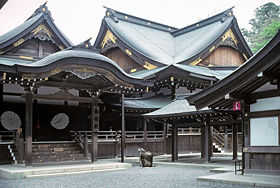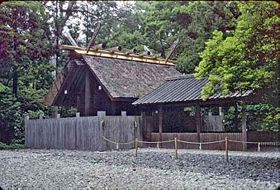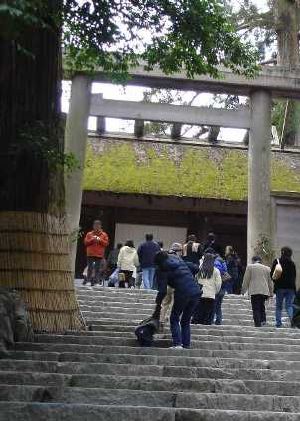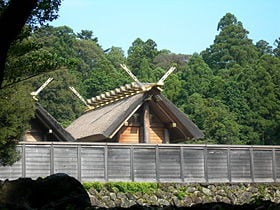Ise Shinto Shrine or Ise Shrine (Ise-jingÅ« ä¼å¢ç¥å®®) is a Shinto shrine to the goddess Amaterasu Åmikami(å¤©ç §å¤§ç¥). The Ise Shrine is popularly regarded as the holiest temple complex in Japan. Located in the city of Ise in Mie prefecture, in southeastern Japan, it is composed of two similar complexes. The earliest complex, called the Naiku (å å®®), or Inner Shrine, is dedicated to the Sun Goddess Amaterasu Åmikami The second complex, the Geku (å¤å®®) or Outer Shrine, is about six kilometers (3.7 miles) away and is thought to have been built in the fifth century for Toyouke no Åmikami ï¼è±å大ç¥å®®ï¼, the Grain Goddess. The sun goddess Amaterasu Omikami is the mythical ancestor of the Imperial family. She is represented by the sacred mirror, one of the three objects symbolic of the divine authority of the imperial family. According to legend, the inner shrine dates from when Princess Yamatohime (å姫å½), daughter of Emperor Suinin (åä»å¤©ç), wandered Japan searching for a final resting place for the sacred mirror. When she reached Ise, she heard the voice of Amaterasu Omikami, saying, "This is a good place, and I would like to stay here."
The Ise-Jingu Shrine is the major sightseeing attraction in Ise, attracting over six million worshipers every year.
Ise JingÅ«(ä¼å¢ç¥å®®)
Officially known simply as JingÅ« or "The Shrine," Ise JingÅ« is in fact a shrine complex composed of over one hundred individual shrines (said to number one-hundred-and twenty-five shrines), divided into two main parts. GekÅ« (å¤å®®), or the Outer Shrine, is located in the town of Yamada and dedicated to the deity Toyouke no Åmikami, while NaikÅ« (å å®®), or the Inner Shrine, is located in the town of Uji and dedicated to Amaterasu Åmikami. The two are located some six kilometers apart, and joined by a pilgrimage road that passes through the old entertainment district of Furuichi. The High Priest or Priestess of the Ise Shrine must come from the Japanese Imperial Family, and watches over the Shrine.
According to the official chronology, the shrines were originally constructed in the year four B.C.E., but most historians date them from several hundred years later, with 690 C.E. widely considered the date when the shrines were first built in their current form. Legends say that NaikÅ« was established by Yamatohime-no-mikoto. The shrines are mentioned in the annals of the Kojiki and Nihonshoki (dating from 712 and 720, respectively). Every twenty years, at an exorbitant cost, the old shrines are dismantled and new ones built to exacting specifications which recreate the original design from the third or fourth century, so that the buildings will be forever new and forever ancient and original. The new shrines are not regarded as replicas, but are âIse re-created,â representing the Shinto concept of nature, which is always renewed and reborn. The present buildings, dating from 1993, are the sixty-first iteration to date and are scheduled for rebuilding in 2013.
All the building material for the roofs, floors and ornaments of both structures comes entirely from Japanese white cypress, hinoki. The main building of the Inner Shrine is designed in a special architectural style, called shimmei-zukuri (ç¥æé ) which is prohibited for any other shrines. Its simple rectangular design is said to derive from the granaries and treasure storehouses of prehistoric Japan.
The design of Ise Shrine precedes the introduction of Buddhism and Chinese influence on architecture, so that it offers an intriguing example of indigenous Japanese architecture before it was superseded by these more recent influences. The buildings are made of natural wood, with the distinctive roof beams consisting of the Chigi, which rest on free-standing columns at either gabled end and protrude like horns over the ridge of the roof; and the Katsuogi, short logs laid horizontally across the ridge of the roof. Overall, the style is somewhat reminiscent of Polynesian architecture.
The Ise Shrine has a national treasure in its possession. Purportedly the home of the Sacred Mirror, the shrine is regarded as Shinto's holiest and most important site. Access to both sites is strictly limited, with the common public allowed to see little more than the thatched roofs of the central structures, hidden behind three tall wooden fences.
The region around the shrines is the Ise-Shima National Park and has numerous other holy and historic sites including the 'wedded rocks' Meoto Iwa, and the Saiku (the site of the Heian period imperial residence).
The Establishment of the Shrine
According to Japanese legend, around two thousand years ago the divine Yamatohime-no-mikoto, daughter of the Emperor Suinin, set out from Mt. Miwa in modern Nara Prefecture in search of a permanent location to worship the goddess Amaterasu-omikami, wandering for twenty years through the regions of Ohmi and Mino. Her search eventually brought her to Ise, in modern Mie Prefecture, where she is said to have established Naikũ after hearing the voice of Amaterasu Omikami saying that she wanted to live forever in the richly abundant area of Ise, near the mountains and the sea. Prior to Yamatohime-no-mikoto's journey, Amaterasu-omikami had been worshiped at the Imperial residence in Yamato, then briefly at a temporary location in the eastern Nara basin.
The High Priestess / High Priest of the Shrine
From the late seventh century until the fourteenth century, the role of High Priestess of Ise Shrine was carried out by a female member of the Japanese Imperial Family, known as a SaiÅ (æç). According to the Man'yÅshÅ« (ä¸èé ) (The Anthology of Ten Thousand Leaves), the first SaiÅ to serve at the shrine was princess Okunohime-miko ( 大æ¥ç女), daughter of Emperor Temmu (天æ¦å¤©ç), during the Asuka period (é£é³¥æ代) of Japanese history. Mention of Ise Shrine's SaiÅ is also made in the Aoi, Sakaki and Yugao chapters of The Tale of Genji, as well as in the sixty-ninth chapter of The Tales of Ise (Ise Monogatari). The SaiÅ system ended during the turmoil of the Nambokucho Period.
Since the disestablishment of state Shinto during the Allied Occupation of Japan after World War II, the offices of high priest and most sacred priestess have been held by former members of the imperial family or their descendants. The current High Priest of the Shrine is Kitashirakawa Michihisa, a great grandson of the Emperor Meiji (æ治天ç). He suceeded his cousin Kuni Kuniaki, the eldest son of former Prince Kuni Asaakira (ä¹ éå®® æèç) (brother of Empress KÅjun (é¦æ·³çå)), in 2001. Kitashirakawa's grandmother, Kitashirakawa Fusako, the seventh daughter of Emperor Meiji, served as most sacred priestess of the Ise Shrine from 1947 until her death in 1974. She was succeeded in that post by Takatsukasa Kazuko, the third daughter of Emperor ShÅwa (æå天ç), who held the post until ill health forced her retirement in 1988. Takatsukasa was succeeded by her younger sister, Ikeda Atsuko (æ± ç° åå).
Naikū - The Inner Shrine
The official name of NaikÅ«, the main shrine and place of worship of the goddess Amaterasu-omikami, is "Kotaijingu" ï¼ç大ç¥å®®ï¼. The grounds of NaikÅ« contain a number of structures, including the following:
The Uji Bridge (å®æ²»æ©)
This wooden bridge in traditional Japanese style stands at the entrance of NaikÅ« and spans one hundred meters across the river Isuzu (äºåé´å·). Like the actual shrine building, the bridge is reconstructed every 20 years as a part of the Shikinen Sengu ceremony (å¼å¹´é·å®®).
Temizusha (ææ°´è)
After they enter Naikū via the Uji Bridge and pass through a landscaped garden, the next building encountered by pilgrims to the shrine is Temizusha. This small, roofed structure contains a pool of water for use in ritual purification. Visitors are encouraged to wash their hands and rinse their mouths at Temizusha as a symbolic act to clean the mind and body of impurity.
Kotaijinguï¼ç大ç¥å®®ï¼- the Main Shrine
After passing through the first and second sacred Torii (é³¥å± ) gates, pilgrims approach the main shrine of NaikÅ« by a set of large stone steps. Though the actual shrine is hidden behind a large fence, pilgrims can approach the gate to offer their prayers. Photographs in this area are prohibited and this restriction is strictly policed.
Kotaijingu is said to hold the Sacred Mirror, one of three sacred items given to the first emperor by the gods. From a path that follows the line of the outer wall, the distinctive roof of the shrine building can be seen through the trees. In front of the walled shrine compound can be seen an open area which will be the location of the next rebuilding of the shrine in 2013.
Construction of the Shrine
Historically, trees and stones have been objects of devotion in Japan. Originally, shrines did not have any buildings; instead a tree, forest, large boulder or a mountain, festooned with ropes, served as the focus of worship. The mysterious forces of nature (ke) were thought to permeate palpable matter and formless space to create mononoke, which coalesced in certain trees and stones. For this reason, trees such as the cryptomeria and the evergreen sakaki, were held to be sacred, and when one of these trees was cut down and the wood used to construct a shrine, the same sacred quality was transferred to the building. The sacred tree was considered to be literally and symbolic present in a pillar or post around which the shrine was built. The great Shinto shrine at Ise is built in a dense forest of giant cryptomeria trees next to the Isuzu River at the foot of Mount Kamiji and Mount Shimaji. The area, and the cryptomeria trees that grew on it, were already sacred before Emperoro Temmu established the site as the principal cult shrine of Imperial Japan. The present buildings at Ise Shrine reproduce the temple ceremoniously rebuilt for the first time in 692 C.E. by Empress Jito. The original temple had been built by her husband, Emperor Temmu (678-686), the first emperor to rule over a united Japan. Besides trees, the Ise Shrine holds many subsidiary shrines made of rocks from the sea, which are regarded as the abodes (iwakura or rock abodes) of deities.
The chambers of the shrines are raised on timber piles which represent the central sacred post. The roof is not supported by the walls; instead the ridge beam is carried by two large columns at either end of the building, which are embedded directly in the ground without any foundation.
Both main shrines are constructed entirely of wood. Every twenty years they are completely rebuilt on an adjoining site, and the empty site of the previous shrine (the kodenchi) is strewn with large white pebbles. The empty site, which retains its sacredness for the intervening twenty years, contains one small wooden shed (oi-ya) which shelters a post about seven feet high known as shin-no-mihashira (the august column of the heart, or â sacred central postâ). Cryptomeria trees are associated with Shinto shrines, but the principal sacred plant of the Shinto is the sakaki (a shrub related to the tea bush). The shin-no-mihashira (true pillar) is taken to represent a branch of the sakaki stuck upright in the ground. The new shrine is erected over and around the shin-no-mihashira, which are considered the holiest and most mysterious objects at Ise Shrine. The shin-no-mihashira remain hidden from view at all times.
The erection of a single post in the center of a sacred area strewn with stones represents the form taken by Japanese places of worship in very ancient times; the shin-no-mihashira would thus be the survival of a symbolism from a very pimitive symbolism to the present day. (Kenzo Tange and Noboru Kawazoe, Ise: Prototype of Japanese Architecture, Cambridge, Massachusetts: M.I.T. Press, 1965.)
ReferencesISBN links support NWE through referral fees
- Asahi Shinbunsha, KenzÅ Tange, and Noboru Kawazoe. 1965. Ise, prototype of Japanese architecture. Cambridge, Mass: M.I.T. Press.
- Ise Daijingū. 1979. Jingū: the grand shrine of Ise. Ise, Japan: The Office of the Shrine.
- Johnson, Norris Brock. 1992. Temples in traditional environments. Traditional dwellings and settlements working paper series, v. 49. Berkeley, CA: Center for Environmental Design Research, University of California, Berkeley.
- Public Relations Section for the Regular Removal of Grand Shrine of Ise. 1993. Jingū, Japan's spiritual home. Tokyo: Public Relations Section for the Regular Removal of Grand Shrine of Ise.
- Stevenson, Neil. 1997. Architecture. Annotated guides. New York: DK Pub. ISBN 0789419653
- Studies in ancient Japanese history. 1995. Tokyo: TÅhÅ Gakkai.
- Teeuwen, Mark. 1996. Watarai Shintô: an intellectual history of the outer shrine in Ise. Leiden, the Netherlands: Research School CNWS. ISBN 9073782791
Credits
New World Encyclopedia writers and editors rewrote and completed the Wikipedia article in accordance with New World Encyclopedia standards. This article abides by terms of the Creative Commons CC-by-sa 3.0 License (CC-by-sa), which may be used and disseminated with proper attribution. Credit is due under the terms of this license that can reference both the New World Encyclopedia contributors and the selfless volunteer contributors of the Wikimedia Foundation. To cite this article click here for a list of acceptable citing formats.The history of earlier contributions by wikipedians is accessible to researchers here:
The history of this article since it was imported to New World Encyclopedia:
Note: Some restrictions may apply to use of individual images which are separately licensed.




